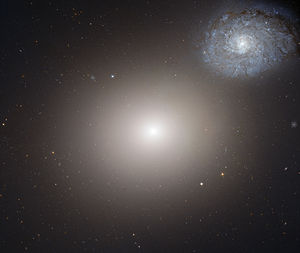Messier 60
| Galaxy Messier 60 |
|
|---|---|

|
|
| Hubble image of Messier 60; top right: NGC 4647 | |
| AladinLite | |
| Constellation | Virgin |
|
Position equinox : J2000.0 , epoch : J2000.0 |
|
| Right ascension | 12 h 43 m 40.0 s |
| declination | + 11 ° 33 ′ 10 ″ |
| Appearance | |
| Morphological type | E2 |
| Brightness (visual) | 8.8 likes |
| Brightness (B-band) | 9.8 likes |
| Angular expansion | 7.6 ′ × 6.2 ′ |
| Position angle | 105 ° |
| Surface brightness | 13.1 mag / arcmin² |
| Physical data | |
| Affiliation |
Virgo Galaxy Cluster , LGG 292 |
| Redshift | +0.003726 ± 0.000020 |
| Radial velocity | (+1117 ± 6) km / s |
|
Stroke distance v rad / H 0 |
(47 ± 3) · 10 6 ly (14.5 ± 1) Mpc |
| diameter | 120,000 ly |
| history | |
| discovery | Johann Gottfried Koehler |
| Discovery date | April 11, 1779 |
| Catalog names | |
| M 60 • NGC 4649 • UGC 7898 • PGC 42831 • CGCG 071-016 • MCG + 02-33-002 • 2MASX J12434000 + 1133093 • Arp 116 (together with NGC 4647) • VV 206a • GC 3182 • h 1408 • Holm 448A • KPG 353B | |
Messier 60 (also known as NGC 4649 ) is an 8.8 mag bright elliptical galaxy in the constellation Virgo .
M 60 was discovered together with the neighboring galaxies M 58 and M 59 during the observation of the comet in 1779. Johann Gottfried Köhler discovered the galaxy on April 11th, Barnaba Oriani discovered it a day later and Charles Messier finally discovered it independently four days later. The galaxy is in the Virgo galaxy cluster, next to the most massive galaxy M 87 and the brightest galaxy M 49, the third giant elliptical galaxy and main galaxy of the subgroup Virgo cluster C. This group forms the easternmost part of the galaxy cluster and M 60 itself is the easternmost object of the Virgo -Haufens in the Messier catalog.
M60 is about 120,000 light years in diameter and has a mass of about 1 trillion solar masses . In the Hubble sequence , the galaxy is of type E2, so it is slightly flattened. M 60 has a relatively densely populated halo with around 5,000 globular clusters . An interesting detail even in the small telescope is the nearby companion NGC 4647 , a spiral galaxy . It was assumed that both galaxies interact gravitationally with each other, and summarized them under Arp 116 ; However, recent studies do not confirm this. Halton Arp organized his catalog of unusual galaxies into groups according to purely morphological criteria. This galaxy belongs to the class of elliptical galaxies close to spiral galaxies and disturbing them (Arp catalog) .
On January 28, 2004, a type Ia ( SN 2004W ) supernova with a brightness greater than 18.8 mag was discovered in M 60 by the Lick Observatory Supernova Search (LOSS).
At the beginning of 2008, a team of American and Italian researchers succeeded in determining the mass of the black hole in the center of the galaxy. To do this, they measured the temperature of the hot gas in the center of M 60 with the help of the Chandra X-ray satellite , from which the mass of the black hole can be derived indirectly (the hotter the gas, the heavier the black hole). The black hole has a mass of 3.4 billion solar masses, which is more than a thousand times that of the black hole in the center of our Milky Way.
The companion galaxy M60-UCD1, an ultra-compact dwarf galaxy 22,000 light years away from M60 , was discovered in 2014 to house a supermassive black hole. Most of the stars and outer dark matter were probably torn away from it in a collision with M60 ten billion years ago.
Web links
- Spektrum.de : Amateur recordings [1]
- astronews.com: View of an unequal pair of galaxies September 7, 2012
- astronews.com: Picture of the day April 11, 2013
- ARP ATLAS OF PECULIAR GALAXIES
- Seligman Arp
literature
- Jeff Kanipe and Dennis Webb: The Arp Atlas of Peculiar Galaxies - A Chronicle and Observer's Guide " , Richmond 2006, ISBN 978-0-943396-76-7
Individual evidence
- ↑ a b c d NASA / IPAC EXTRAGALACTIC DATABASE
- ↑ a b c d e SEDS : NGC 4649
- ↑ Seligman
- ^ A. Franco-Balderas, HM Hernández-Toledo, D. Dultzin-Hacyan, M. Rosado: BVRI Surface Photometry of Mixed Morphology Pairs of Galaxies. III. The Third Data Set. 2005, bibcode : 2005RMxAA..41..483F .
- ↑ R. de Grijs, ARI Robertson: Arp 116: interacting system or chance alignment? 2006, bibcode : 2006A & A ... 460..493D .
- ↑ SEDS: Supernova 2004W in M60. ( Memento from July 18, 2012 in the web archive archive.today ).
- ↑ ScienceTicker Astro: More mass, more heat.
- ↑ Harald Zaun: A monster pulsates in the center of a dwarf galaxy. Welt, September 18, 2014.
- ↑ Anil Seth, Matthias Frank, Nadine Neumayer and others: A supermassive black hole in an ultra-compact dwarf galaxy. In: Nature. Volume 513, 2014, pp. 398-400, abstract.


